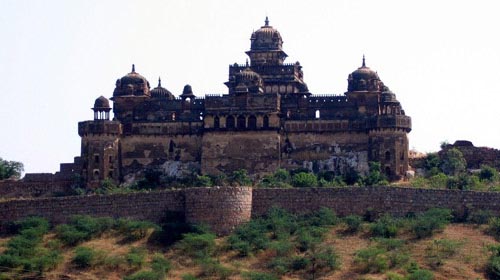Veer Singh Palace

Information on Veer Singh Palace (Datia, Madhya Pradesh) - History & Architecture
Veer Singh Palace is located in the north central district of Datia, in the state of Madhya Pradesh in Central India. It is a medieval palace that has historical and architectural significance in this state. In the Mahabharata, this ancient town is cited as Daityavakra. This particular palace is one of the most sought after palaces that are visited by local and foreign tourists with a lot of interest. It is the best well-preserved courtly palace structure. It is about 320 km north of Bhopal, 325 km south of New Delhi and 69 km from Gwalior.
Veer Singh Palace Architecture
Veer Singh Palace and its beautiful garden are surrounded by a stone wall in the old town of Datia. The southern side of this palace over looks a large lake named the Karna Sagar. On the eastern side is the main entrance. In North India, one of the best examples of Hindu domestic architecture is this 17th-century palace built by Raja Veer Singh Deo in 1614. It is a seven story magnificent palace. It is located on a low hill of this region. It took nearly nine year to complete the construction of this large structured palace. There is no trace of either of iron or wood but it is built purely of bricks and stone. It is built with perfection in the form of a square. With four octagonal towers, the monotony is largely being relieved. The summit of this seven storied building is ornamented by several chhatris that are attractively crowned with well-designed ribbed domes. The ceilings of most of the chambers are exquisitely carved. This palace is locally known as Govind Mandir. There are several underground chambers in this palace.
Veer Singh Palace History
In 1549, the state of Datia was founded. In 1626, 1st Rao of Baroni and Datia, Rao Bhagwan Rao received Baroni and Datia from his father, Bir Singh Deo, Raja of Orchha. He established his own state in a successful manner. In 1676, he died. In 1802, this princely state directly came under British control under the Treaty of Bassein with other territories in Bundelkhand. With the Peshwa, this treaty was formed. Maharaja Rao Raja was the ancient title of this ruling family, but the British Government largely recognized only the title of Maharaja in 1865 as hereditary. It is t be remembered that the Peshwa maintained for the British a military force of 5203 infantry, 945 cavalry plus armed with 3,000,000 guns and other ammunitions.
The royal family's motto was Wir dalap Sharandah which mean Giver of Refuge and Lord of the Brave Army. The state suffered from famine in 1896-97 and 1899-1900. In 1947, after India's independence, the Maharaja of Datia immediately acceded with the dominion of India. With the Union of India, it later merged successfully. In 1950, with the rest of the Bundelkhand agency, Datia together became part and parcel of the new state of Vindhya Pradesh. This new state was merged with certain other region to form the present state of Madhya Pradesh within the Union of India in 1956.
Veer Singh Palace Tourism Importance
Veer Singh Palace is situated on the track from Gwalior to Jhansi at Datia. The nearest airport is at Indore. The town of Datia is on the Delhi-Mumbai railway line. There is no entry fee is charged on the visitors. A visitor needs a day's time to go around and enjoy the unique architectural beauty of this palace. It is the best place to visit with family members and dear ones.
- Andaman Nicobar Monuments
- Andhra Pradesh Monuments
- Assam Monuments
- Bihar Monuments
- Chhattisgarh Monuments
- New Delhi Monuments
- Goa Monuments
- Gujarat Monuments
- Haryana Monuments
- Himachal Pradesh Monuments
- Jammu and Kashmir Monuments
- Karnataka Monuments
- Kerala Monuments
- Madhya Pradesh Monuments
- Maharashtra Monuments
- Odisha Monuments
- Punjab Monuments
- Rajasthan Monuments
- Tamil Nadu Monuments
- Telangana Monuments
- Uttar Pradesh Monuments
- West Bengal Monuments